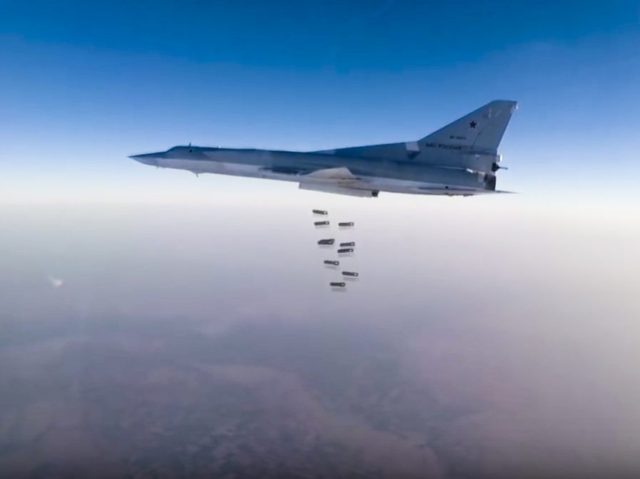Russian warplanes flew bombing missions into Syria from the Hamedan airbase in western Iran on Tuesday, in a significant step toward closer Russian-Iranian cooperation.
As CNN observes, this was the first time a major world power has used an Iranian airbase for military operations since the Islamic Revolution in 1979:
Tu-22M3 long-range bombers and Su-34 tactical bombers took off from Hamedan airbase in western Iran Tuesday, and hit targets belonging to ISIS and the Jabhat al-Nusra militant group in the Syrian provinces of Aleppo, Deir Ezzor and Idlib, Russia’s defense ministry said in a statement.
The raids “eliminated” five major arms depots, used to supply ISIS militants near the city of Aleppo, as well as three militant command points and training camps in the cities of Serakab, Al-Bab, Aleppo and Deir Ezzor.
A “significant number of militants” were also thought to be killed, the ministry said.
All Russian aircraft returned to their home airfields safely after a successful “combat mission,” the statement added.
Although most headlines describe these missions as Russia using an Iranian base to target ISIS, Baghdad-based U.S. military spokesman Col. Chris Garver told Fox News that only one of the three areas in Syria hit by these Russian strikes had concentrations of ISIS fighters.
Garver further noted that two of the Russian airstrikes were conducted near the besieged city of Aleppo, where non-ISIS rebel forces recently announced a surprise victory against Syrian government forces. Opposition forces claimed at least 15 civilians were killed and wounded by either Russian or Syrian government airstrikes near Aleppo on Tuesday.
The Russian Defense Ministry described all of its targets as “terrorist objects in Syria.”
“With constructive and extended cooperation between Iran, Russia and Syria and the resistance front, the situation has become very tough for terrorists and the trend will continue until the complete destruction of them,” declared Ali Shamkhani, secretary of Iran’s Supreme National Security Council. By “them” he purportedly means ISIS, while the “resistance front” he mentioned is Iran’s puppet terrorist operation, Hezbollah.
In theory, Russia’s cooperation with Iran could be a significant problem for the U.S. government. CNN quotes Secretary of State John Kerry threatening a “Plan B” to “increase arms to Syrian rebels if Russia and Assad did not change tactics and stop targeting moderate opposition groups supported by the US and its European and Arab partners.” There have also been widespread complaints about civilian casualties in the areas struck by Russian and Syrian warplanes.
In practice, the U.S. is moving inexorably closer to accepting Russia, Iran, and Syria’s view of the civil war. The Russians, who care little for Barack Obama’s “red lines” or the administration’s desire for regime change in Damascus, are boasting of closer cooperation with the U.S. against terrorist forces in Syria — and they, like Iran and the Assad regime, define all armed opposition to the Syrian dictatorship as “terrorists.”
The New York Times suggests Russia’s use of the Iranian air base, along with Moscow’s effort at strengthening ties with Turkey, “could help solidify Russia as the main broker of any future peace agreement in Syria.”
The Times also observes that using Iran’s airbase cuts the flight time to the Aleppo region by about 60 percent for Russian bombers, allowing them to carry heavier payloads. An urgent need to increase payloads could be taken as a sign that rebel forces have dealt Assad significant setbacks on the battlefield, coming back from the brink of what looked like a rout after Russia became involved in the war.
Also of interest: the Times suggests no one outside of the Iranian and Russian governments is quite certain when the deal to allow Russian warplanes to fly out of the Hamedan airbase, or what else might be included in the deal.
The Wall Street Journal notes that Russia’s warming to Iran began with a promise to deliver advanced S-300 surface-to-air missiles, made near the end of negotiations on the Iranian nuclear deal. Iran has said, “significant components” of this system have been delivered by Russia as promised.
The Iranians were asking for some arms deliveries and a good price, and we [the Russians] had our own demands, likely including the request to use the Iranian air base,” Moscow-based analyst Ruslan Pukhov told the Journal.
One curious piece of the puzzle is Iraq’s role. As the WSJ points out, Russian planes departing from Hamedan would most likely have to pass through Iraqi airspace to hit Syria, but Iraqi Prime Minister Haider Abadi said on Tuesday that Moscow did not file a request to fly over Iraqi territory.
Abadi nevertheless said he supported the airstrikes because “he feels a duty to assist military strikes on Islamic State in Syria, though to remain mindful of civilian populations.”

COMMENTS
Please let us know if you're having issues with commenting.